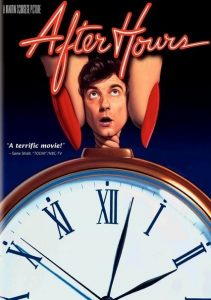After Hours-1985
Director Martin Scorsese
Starring Griffin Dunne, Rosanna Arquette
Scott’s Review #1,069
Reviewed October 9, 2020
Grade: A-
After Hours (1985) is a gem of a film.
When thoughts of director Martin Scorsese are conjured, Taxi Driver (1976), Raging Bull (1980), or Goodfellas (1993) are films that immediately spring to mind.
Scorsese’s decision to create a pared-down independent film was met with enormous success and accolades for the very first Best Feature indie film victory and Best Director honors.
The experience is a black comedy set within the gritty and unpredictable underbelly of Soho-New York City in the 1980s.
Mixing comedy with satire, Scorsese leapfrogs from similar content in The King of Comedy (1983) to this film made only two years later.
Any fan of New York City will cheer with joy at the authenticity achieved since the film was shot on location there. The Big Apple in the 1980s was a notoriously violent cesspool so the genuine setting and the use of dark streets and alleys is an immeasurable treat and adds much zest to this unusual film.
A nice guy, Paul Hackett (Griffin Dunne), works hard as a computer data entry worker by day and shares an encounter with a quirky young woman named Marcy Franklin (Rosanna Arquette) in a Manhattan coffee shop.
After she gives him her number and leaves, he is unable to stop thinking about her and embarks on a late-night adventure to go and see her at her apartment.
The night does not end how he thinks it will. Not by a long shot, as he spends the rest of the long night meeting various women and other strange characters as he traverses around the city attempting to get back home. He has lost his money and is broke.
The great aspects of After Hours are its bizarre characters and the cinematography that offers a tantalizing view of downtown Manhattan. The film is atmospheric and zany in its gloomy and steamy side streets and odd locales sprinkled with color.
A dingy bar, a sophisticated artist’s apartment, and a man sculpture that follows Paul everywhere are usurped by the film’s strangest and most interesting set, Club Berlin, an “after-hours” club inhabited by punks who want to shave Paul’s head into a mohawk.
I enjoyed this film as a sort of “A Day in the Life of Paul” adventure story, albeit a gothic one. The film concludes wonderfully as the sun begins to rise just as the film ends and thus Paul’s wild night finally ends.
I was chomping at the bit with the thought of what a new morning would bring and the possibilities of reuniting with any of the women he encountered the night before, either dead or alive.
Particularly charming to me while watching After Hours, the decade of decadence well into the past, are the relics once commonplace in everyday life. A phone booth, the traditional yellow cabs, and desktop personal computers are heavily featured.
These items, relevant when the film was made, now seem like throwback niceties that make the film endearing and like a glimpse into someone’s time capsule.
I did not pick up on much authentic romance between Paul or any of the female characters- Marcy, June, Gail (Catherine O’Hara), or Julie (Teri Garr), but maybe that’s the point. While one winds up dead, not one, but two of them pursue him, and not in a good way.
The film is mystical, weird, and energetic. The inclusion of Cheech & Chong only adds to the revelry.
Sadly, underappreciated and too often forgotten, After Hours (1985) is a Scorsese treat worth dusting off now and then. The birth of the Independent Spirit Awards has a lot to owe to this film for grabbing top honors and the admiration works both ways.
For a glimpse at the creative genius that is Martin Scorsese, this film gets an enormous recommendation.
Independent Spirit Award Nominations: 2 wins-Best Feature (won), Best Director-Martin Scorsese (won), Best Female Lead-Rosanna Arquette, Best Screenplay, Best Cinematography
